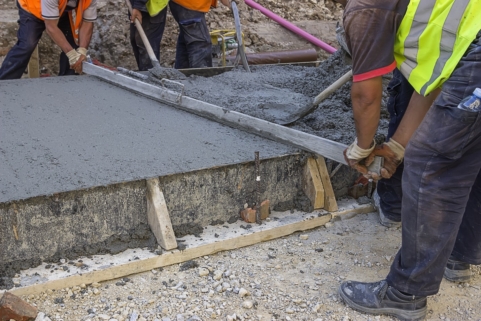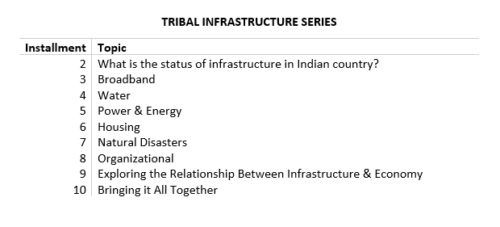SEE Renewal’s Tribal Infrastructure Series – Installment 1
Series written by Amy Wilson and Tessa McLean
SEE Renewal’s Tribal Infrastructure Series is sequence of ten (10) articles developed to take an in-depth look at physical and organizational infrastructure in Indian country. The purpose of the Tribal Infrastructure Series is not to engage in the infrastructure debate, but rather to evaluate funding opportunities, discuss current issues and topics related to infrastructure in Indian country, and explore core elements of President Biden’s Build Back Better plan.
Our goal is to help the reader (1) be up to date on the status of infrastructure in Indian country, (2) understand relationships amongst the various funding opportunities, (3) consider non-traditional sources that can be leveraged to catalyze investments, and (4) consider program sustainability and explore key elements needed to initiate a sustainable strategy.
1. Overview
2. What is the status of infrastructure funding?
3. Why is the Tribal Infrastructure important and how will it benefit you?
4. What is next in the Series?
1. Overview
This is the first installment of a ten (10) part Tribal Infrastructure Series. In this installment, we set the foundation for the series by outlining key information relating to the American Rescue Plan, INVEST in America Act, and the Make America Better Plan.
2. What is the status of infrastructure funding?
The American Rescue Plan (ARP) Act of 2021 was signed into law on March 11, 2021, to provide direct relief to the American people and help individuals, families, and communities recover from hardships caused by the pandemic and rescue the economy. The $1.9 trillion ARP package is the first part of President Biden’s three-part agenda under the Build Back Better plan.
Pursuant to the Coronavirus State and Local Fiscal Recovery Funds provision of the ARP, $20 billion in funding will be distributed to eligible tribal governments under the U.S. Department of the Treasury. The purpose is to support recovery efforts related to public health expenditures; address negative economic impacts caused by the health emergency; provide premium pay for essential workers; and invest in water, sewer, and broadband infrastructure. In addition, the ARP invests $1.75 billion in American Indian and Alaska Native government programs administered under the oversight of the Bureau of Indian Affairs (BIA) and Bureau of Indian Education (BIE) and directed to potable water delivery, housing improvement, tribal government, social services, public safety and justice, Indian child welfare, administrative and oversight costs, and other related expenses.
Most recently, the U.S. House of Representatives approved a $715B surface transportation and water infrastructure bill, known as the INVEST in America Act. While the deal significantly cuts President Biden’s initial American Job’s Plan proposal, the infrastructure package includes core areas of spending for physical infrastructure, including investments in water and wastewater infrastructure, drinking water infrastructure and assistance, broadband, power infrastructure, roads, bridges, and other infrastructure.
Major components of the Make America Better plan are highly debated; most notably, infrastructure. Overall spending priorities also remain unclear. What is clear, however, is the new and unprecedented prospects for tribal nations to access resources needed to enhance on-reservation communities and strengthen tribal economies. While it will never be enough, the prospects present opportunities for Indian Country that did not exist previously. If leveraged correctly, the array of federal relief monies and other federal and non-traditional funding can be used to successfully spur economic development and improve infrastructure in Indian country.
3. Why is the Tribal Infrastructure Series important and how will it benefit you?
We have developed the Tribal Infrastructure Series because we know that having a lot of choices available can lead to snap judgments or even no decision at all because working through all the options is confusing. We have enough experience to know that quick decisions often result in putting valuable resources towards pursuing the wrong opportunities or those opportunities that fail to align with organizational goals, programs, and capacities. The outcome is multiple short-lasting initiatives that fail to get traction and keep the momentum needed to produce long-term benefits.
By taking time to thoughtfully consider federal funding programs and the purpose behind those programs, we can better understand opportunities and begin to identify where programs, non-traditional funding sources, and other prospects align with organizational goals. Afterall, the end-goal is to meet immediate needs, create opportunity, sustain tribal programs, and achieve long-term goals, correct?
We want to help you carefully assess options, identify how resources can be leveraged to the fullest extent, and devise the most effective and efficient path towards better conditions. It is about utilizing resources to build, repair and maintain, but also doing what is needed to enhance capacities and build the knowledge needed to stay on course and surpass past and current achievements.
4. What is next in the Series?
We will release nine installments over the coming weeks.
Subscribe to our mailing list to receive the next installment by email or follow us on Facebook and LinkedIn!









